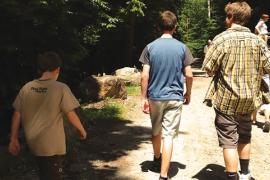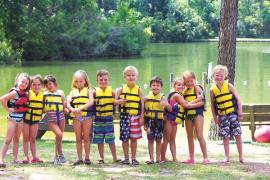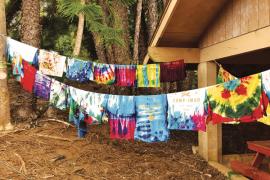In between all the wonderful events you have during your camping program this year, there will always be those random moments of opportunity. Every one of you should have a dozen or more ideas of how to fill that time. But more importantly than just filling the time, you should have some ideas for how to create something wonderful and even memorable with those special moments and minutes. Using that time to create unity, community, and connection can make your entire camp’s culture a very positive one. Here are a few of my favorite techniques for filling some of your group’s empty moments with something wonderful.
Wah!
Wah has become one of my favorite games of all time. High energy, great theatrics, and quick play make it a permanent part of my personal top ten activities, ever!
Wah is a game of the samurai. (Well, probably not, but it is fun to frame it that way!) So when you say, “Wah!” you can’t say it with a New York accent. You need to say it like a samurai: “WAH!”
There are three basic movements to this game. Begin with multiple circles of about eight people in Wah position — feet slightly spread (like the capital letter A), hands together and pointed forwards. In each circle, one person will volunteer to begin the game.
This first person gains eye contact with another person, points to them with both hands and says, “Wah!” The second person now raises both of her hands straight up over her head, and says, “Wah!” The third and final move involves person one and person three standing on each side of person two and making non-contact lumberjack chopping motions toward person two, and also saying “Wah!”
If each person completes their task and says “Wah!” with gusto and on time, the game continues. But, if anyone is early or late in the performance of their duty, or they just mess up, they are out of the game. But the good news is they are not permanently out of the game. They can quickly move to another circle and immediately get back into the game.
After the third movement is completed, person number two (whose hands are still raised high above their head) becomes the first person in the next round, points to one of her group members, and evokes the command, “Wah!” And the game continues.
The Invisible Obstacle Course
This warm-up activity is part creativity and part physical fitness. A volunteer in each small group is selected to begin the activity. Each group will create an imaginary obstacle course, with group members crawling, jumping, running, and helping each other through the obstacles they encounter. After each element, leadership changes and another member of the group describes their obstacle and helps the members of their group navigate over, under, through, or around it.
In the process, a variety of obstacles can be encountered by the group (climbing a giant marshmallow mountain, for example), creativity and leadership are explored, and most importantly, the group is warmed-up, energized, and ready for the day.
The Trust Drive
While there are many trust-building techniques, this activity is one of the best for beginning the process of building trust. Begin with partners of similar heights in an open space with no obstacles. One partner stands behind the other, and both face forward. The “front driver” holds onto an imaginary steering wheel and closes his or her eyes. The “backseat driver,” eyes open, places his or her hands on the driver’s shoulders and tells the driver, “I’ve got your back.” The front driver controls the speed, while the rear driver provides information and direction (sort of a human GPS system), avoiding collisions with other drivers and fixed objects.
After a few minutes, the front driver opens his or her eyes and provides the following feedback to the backseat driver: What was good about his or her technique? What could he or she do to be even better? Next the two participants exchange roles, after which another feedback session is provided.
This is an excellent activity for beginning a more in-depth trust sequence. Be sure to have plenty of supervision and a safe, level, open space.
You can also use this activity to “diagnose” the readiness of your group to explore activities that require an even higher level of trust and commitment. If you happen to see a few fender-benders or collisions, your group may require additional work before they are prepared to take care of each other. If you observe caution, carefulness, and no accidents, your group is probably ready to proceed to another trust-building activity.
Pulse
Pulse is an outstanding no-prop table game, and it can be played on the floor as well. Begin with a small group of players seated with one hand flat on the surface of a table. Imagine that there is a hinge at each player’s wrist. The group leader begins the pulse by pointing out the direction the pulse will begin to travel (to the right or to the left) and then raising the fingers of his hand (while his wrist stays in contact with the table), and slapping the table once. The pulse moves in the direction stated, and the next person continues by slapping the table once, as the pulse continues to travel around the table.
At any point, a player can slap the table once or twice. If he or she slaps once, the pulse continues in the same direction. If he or she slaps twice, the pulse reverses direction and goes the other way. If anyone around the table lifts even a single finger when it is not his turn, he loses that hand for the duration of the round. Play continues until approximately half of the group has been eliminated, and then players move up to the next higher level of challenge.
Round One — players place just one hand on the table.
Round Two — players use both hands, side-by-side.
Round Three — players use both hands, but cross them (to form an X) so that their right hand is on the left, and their left hand is on the right.
Round Four — players use both hands, but reach outward so that their right hand crosses over the left hand of the person on their right, and their left hand crosses over the right hand of the person on their left, forming Xs with the partner on each side.
Round Five — players revert back to the starting positions in Round Two (two hands, side-by-side) but an additional technique is allowed. If a player slaps the table with a fist, the pulse jumps over the next hand in that direction. If he makes a fist and double-slaps the table, the pulse reverses direction and skips a hand in the new direction.
Ten Reasons for Using Activities That Require No Props
|
Jim Cain, PhD, is the author of ten books filled with team- and community-building activities from around the world. For more information, contact the author at: [email protected]. And for more teambuilding games and other camp-friendly activities, visit: www.teamworkandteamplay.com.
Originally published in the 2013 May/June Camping Magazine.



